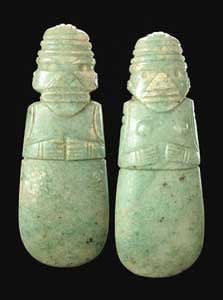Pair of Guanacaste-Nicoya Jade Figure-Celt Pendants, 100 CE - 500 CE
Jade
6
PF.2911
In the context of Pre-Columbian art and archaeology, jade is a generic term that refers to any variety of hard, dense stones that were worked with great skill by native...
In the context of Pre-Columbian art and archaeology, jade is a generic term that refers to any variety of hard, dense stones that were worked with great skill by native artists. Although jade is generally thought to be green, it can actually be a range of colors. Jade carving flourished in ancient Costa Rica for over a thousand years, roughly from 500 B.C. to 900 A.D., although the period of greatest artistic accomplishment lasted from 300 to 700 A.D. It is believed that jade working began during an extended period of agricultural abundance that allowed the ancient society to dedicate part of its energies toward the cultivation of artistic pursuits.
Jade was considered to be a sacred material by the ancient populations of Costa Rica, held in even higher esteem than gold. Generally, it was thought to symbolize that vital life force that sustains us all. The color green is naturally associated with verdant plant life. Specifically, jade was thought to symbolize the sprouting maize plant, that staple of the Pre-Columbian diet. It has also been suggested that jade represents water. Either way, we can be certain that jade represented the very essence of life itself.
To date, no native sources of jade have been discovered in Costa Rica, suggesting an extended trade network existed that imported this precious resource from Mesoamerica into Costa Rica where it was carved by local artists. Such trade also would have brought great wealth and likely reinforced the social stratification of the peoples. Jade may have served as a status marker to distinguish the elite from the masses and solidify their hold on power. We can picture an ancient ruler or shaman presiding over a sacred ceremonial adorned in brilliant green jade pendants and jewelry. The ancient Costa Ricans believe that the system of social hierarchy also extended into the afterlife. Therefore, jade objects were buried with the elite so that their power could be maintained throughout eternity.
This beautifully carved pair of jade pendants represents two solemn anthropomorphic figures, which elude a graceful timelessness. The smoothly carved and polished surface of the pair of jade pendants indicates a fine craftsmanship and a religious effort to create the set of magical pendants. This unique set of pendants shows two figures skillfully carved from one jade. One figure representing a male and the other representing a female, the pair of pendants is a source of spiritual strength that originates from both genders. Worn by chieftains and shamans during ritualistic ceremonies, the vibrant power and magic of the jade pendants were applied to bring prosperity and abundance. Perhaps the pair of pendants of both genders signified fertility and strength of female and male genders. Such precious amulets also indicated rank and authority of chieftains who wore the prized pendants. The mesmerizing quality that feels poignant and hypnotizing surrounds the pair of pendants of both genders. Perhaps such mystical qualities gave the wearer of the pendants a sense of strength and power of each gender. Even across the obstacles of time and culture, these finely carved jade amulets' grace and power are evident today.
Jade was considered to be a sacred material by the ancient populations of Costa Rica, held in even higher esteem than gold. Generally, it was thought to symbolize that vital life force that sustains us all. The color green is naturally associated with verdant plant life. Specifically, jade was thought to symbolize the sprouting maize plant, that staple of the Pre-Columbian diet. It has also been suggested that jade represents water. Either way, we can be certain that jade represented the very essence of life itself.
To date, no native sources of jade have been discovered in Costa Rica, suggesting an extended trade network existed that imported this precious resource from Mesoamerica into Costa Rica where it was carved by local artists. Such trade also would have brought great wealth and likely reinforced the social stratification of the peoples. Jade may have served as a status marker to distinguish the elite from the masses and solidify their hold on power. We can picture an ancient ruler or shaman presiding over a sacred ceremonial adorned in brilliant green jade pendants and jewelry. The ancient Costa Ricans believe that the system of social hierarchy also extended into the afterlife. Therefore, jade objects were buried with the elite so that their power could be maintained throughout eternity.
This beautifully carved pair of jade pendants represents two solemn anthropomorphic figures, which elude a graceful timelessness. The smoothly carved and polished surface of the pair of jade pendants indicates a fine craftsmanship and a religious effort to create the set of magical pendants. This unique set of pendants shows two figures skillfully carved from one jade. One figure representing a male and the other representing a female, the pair of pendants is a source of spiritual strength that originates from both genders. Worn by chieftains and shamans during ritualistic ceremonies, the vibrant power and magic of the jade pendants were applied to bring prosperity and abundance. Perhaps the pair of pendants of both genders signified fertility and strength of female and male genders. Such precious amulets also indicated rank and authority of chieftains who wore the prized pendants. The mesmerizing quality that feels poignant and hypnotizing surrounds the pair of pendants of both genders. Perhaps such mystical qualities gave the wearer of the pendants a sense of strength and power of each gender. Even across the obstacles of time and culture, these finely carved jade amulets' grace and power are evident today.



